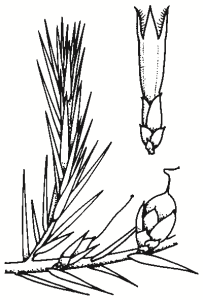Family:
Ericaceae
Astroloma humifusum
Native Cranberry
Other Names: Cranberry Heath

Regional Subspecies:
Occurrence:
Regional:
Noted in the higher rainfall areas: Coppabella; Jingellic and Upper Gilmore.
Habitat:
Ridges and slopes in dry sclerophyll forest over sandstone, shales and basalt, often in disturbed sites.
Habit:
Small, mat-forming densely-branched shrub with branches to 50 cm high. Bright to dark red tubular flowers, particularly May-Sep, and blue-green stiff, prickly narrow leaves.
Site Preference:
Requires well-drained soil. Tolerates frost and extended dry periods.
Characteristics:
Responds well to pruning.
Seed Collection:
Harvest Astroloma seed early Sep to late Mar. Monitor closely as mature seeds shed in 3-14 days.
Propagation:
From cuttings of very young but firm new growth. Difficult to root, and propagate from seed.
VALUES:
Wildlife:
Good habitat — provides nectar for native birds.
First Nations:
The sweet fruits were eaten.
Ornamental:
Widely cultivated for rockeries, embankments, groundcover and planting beneath larger shrubs.
Other:
The sweet fruits can be used in jams and jellies. Apparently not eaten by stock, due to its prickliness.
